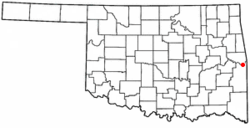Fort Coffee, Oklahoma
| Fort Coffee, Oklahoma | |
|---|---|
| Town | |
 Location of Fort Coffee, Oklahoma |
|
| Coordinates: 35°17′57″N 94°34′48″W / 35.29917°N 94.58000°WCoordinates: 35°17′57″N 94°34′48″W / 35.29917°N 94.58000°W | |
| Country | United States |
| State | Oklahoma |
| County | Le Flore |
| Area | |
| • Total | 6.4 sq mi (16.7 km2) |
| • Land | 6.4 sq mi (16.6 km2) |
| • Water | 0.0 sq mi (0.0 km2) |
| Elevation | 463 ft (141 m) |
| Population (2010) | |
| • Total | 424 |
| • Density | 64/sq mi (24.8/km2) |
| Time zone | Central (CST) (UTC-6) |
| • Summer (DST) | CDT (UTC-5) |
| FIPS code | 40-27150 |
| GNIS feature ID | 1092956 |
Fort Coffee is a town in Le Flore County, Oklahoma, United States. Originally constructed as a U. S. Army fort in 1834, it was named for U. S. General John Coffee, a veteran of the Seminole Wars. It is part of the Fort Smith, Arkansas-Oklahoma Metropolitan Statistical Area. The population was 424 at the 2010 census, a gain of 2.9 percent from 412 at the 2000 census.
The town of Fort Coffee traces its beginning to 1832, when the Choctaw Indian tribe was removed from the southeastern United States and transported to land in the eastern part of Indian Territory (now in the state of Oklahoma). Most of the travel was by water, and the site of Fort Coffee became a port on the Arkansas River.
In 1834, the Choctaw Nation petitioned the U. S. War Department to construct a fort that would stop the flow of alcohol and other illegal items from flowing into their territory along the Arkansas River. The garrison succeeded in its mission and also built roads connecting Fort Smith, Arkansas, Fort Gibson, and Fort Towson. The army abandoned Fort Coffee in 1838 when Fort Smith was reestablished. In 1843, the Choctaw nation allowed the Methodist Episcopal church to establish the Fort Coffee Choctaw Boys Academy in the buildings. This school continued until the outbreak of the Civil War, when Confederate forces commanded by General Stand Watie occupied the site. The Union Army recaptured the fort in 1863. Most of the buildings were burned during this time. Several small houses were built using the foundation stones.
The Choctaw were required to release their slaves by the Reconstruction Treaty of 1866. Many of the freed men remained in the Choctaw Nation lands. Many of these were legally adopted into the Choctaw Nation in 1885, thus qualifying for land allotments by the Dawes Commission.
The local economy has largely been based on agriculture. Major crops included cotton, livestock and soybeans. There was a cotton gin in Fort Coffee to handle locally grown crops. The Fort Smith and Western Railroad and the Kansas City, Pittsburg and Gulf Railway (bought by the Kansas City Southern Railway in 1900) transported the products to outside markets.
...
Wikipedia
